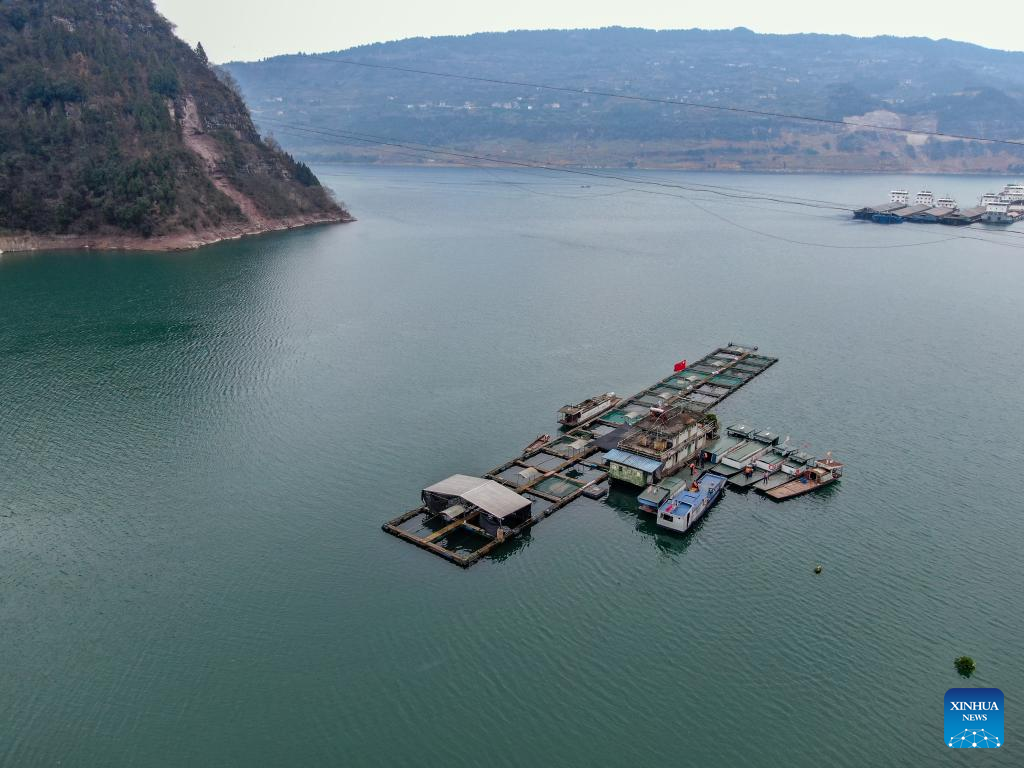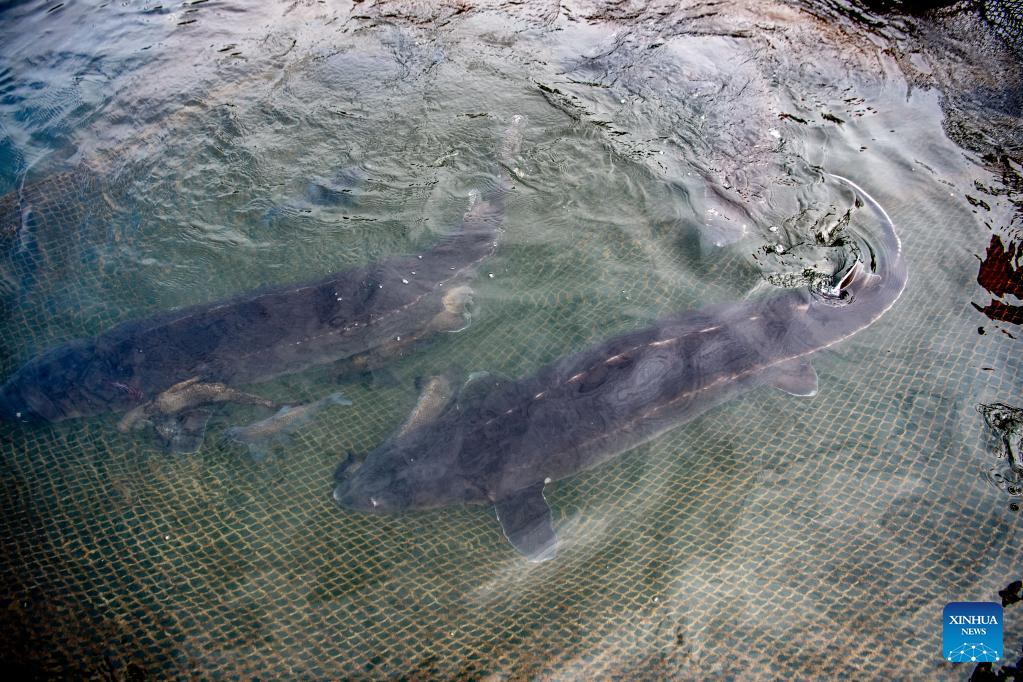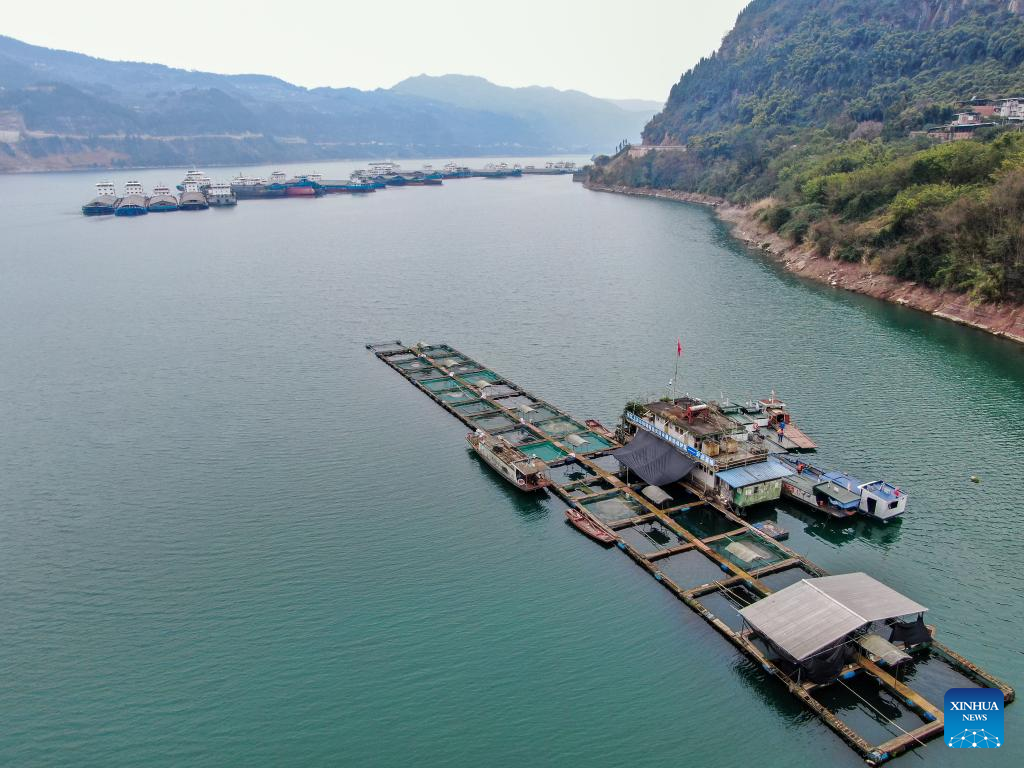Conservation measures achieve results in Yangtze River

A staff member checks the growing situation of the Yangtze sturgeons at a breeding base for rare fishes in the Three Gorges Reservoir in southwest China's Chongqing, Feb. 25, 2022.
Dabry's sturgeon, also known as the Yangtze sturgeon, has lost its natural ability to reproduce since 2000 due to overfishing and crowded rivers, among others. It was classified as critically endangered by the International Union for Conservation of Nature in 2010.
The Yangtze River conservation law that took effect on March 1, 2021, prohibits fishing for productive purposes in the aquatic life conservation areas of the Yangtze basin. Besides, researchers have paid efforts to artificial breeding of the critically endangered species and more local fishermen have devoted themselves to protection of the sturgeons.
The slew of river conservation measures has certainly brought results. The accidental catching and interference of Yangtze sturgeons by fishing activities have been basically eliminated, and traces of Yangtze sturgeons have been found in the river. (Xinhua/Tang Yi)

Aerial photo shows a breeding base for rare fishes in the Three Gorges Reservoir in southwest China's Chongqing, Feb. 25, 2022.
Dabry's sturgeon, also known as the Yangtze sturgeon, has lost its natural ability to reproduce since 2000 due to overfishing and crowded rivers, among others. It was classified as critically endangered by the International Union for Conservation of Nature in 2010.
The Yangtze River conservation law that took effect on March 1, 2021, prohibits fishing for productive purposes in the aquatic life conservation areas of the Yangtze basin. Besides, researchers have paid efforts to artificial breeding of the critically endangered species and more local fishermen have devoted themselves to protection of the sturgeons.
The slew of river conservation measures has certainly brought results. The accidental catching and interference of Yangtze sturgeons by fishing activities have been basically eliminated, and traces of Yangtze sturgeons have been found in the river. (Xinhua/Tang Yi)

Photo taken on Feb. 25, 2022 shows a breeding base for rare fishes in the Three Gorges Reservoir in southwest China's Chongqing.
Dabry's sturgeon, also known as the Yangtze sturgeon, has lost its natural ability to reproduce since 2000 due to overfishing and crowded rivers, among others. It was classified as critically endangered by the International Union for Conservation of Nature in 2010.
The Yangtze River conservation law that took effect on March 1, 2021, prohibits fishing for productive purposes in the aquatic life conservation areas of the Yangtze basin. Besides, researchers have paid efforts to artificial breeding of the critically endangered species and more local fishermen have devoted themselves to protection of the sturgeons.
The slew of river conservation measures has certainly brought results. The accidental catching and interference of Yangtze sturgeons by fishing activities have been basically eliminated, and traces of Yangtze sturgeons have been found in the river. (Xinhua/Tang Yi)

A staff member checks the growing situation of the Yangtze sturgeons at a breeding base for rare fishes in the Three Gorges Reservoir in southwest China's Chongqing, Feb. 25, 2022.
Dabry's sturgeon, also known as the Yangtze sturgeon, has lost its natural ability to reproduce since 2000 due to overfishing and crowded rivers, among others. It was classified as critically endangered by the International Union for Conservation of Nature in 2010.
The Yangtze River conservation law that took effect on March 1, 2021, prohibits fishing for productive purposes in the aquatic life conservation areas of the Yangtze basin. Besides, researchers have paid efforts to artificial breeding of the critically endangered species and more local fishermen have devoted themselves to protection of the sturgeons.
The slew of river conservation measures has certainly brought results. The accidental catching and interference of Yangtze sturgeons by fishing activities have been basically eliminated, and traces of Yangtze sturgeons have been found in the river. (Xinhua/Tang Yi)

Photo taken on Feb. 25, 2022 shows Yangtze sturgeons at a breeding base for rare fishes in the Three Gorges Reservoir in southwest China's Chongqing.
Dabry's sturgeon, also known as the Yangtze sturgeon, has lost its natural ability to reproduce since 2000 due to overfishing and crowded rivers, among others. It was classified as critically endangered by the International Union for Conservation of Nature in 2010.
The Yangtze River conservation law that took effect on March 1, 2021, prohibits fishing for productive purposes in the aquatic life conservation areas of the Yangtze basin. Besides, researchers have paid efforts to artificial breeding of the critically endangered species and more local fishermen have devoted themselves to protection of the sturgeons.
The slew of river conservation measures has certainly brought results. The accidental catching and interference of Yangtze sturgeons by fishing activities have been basically eliminated, and traces of Yangtze sturgeons have been found in the river. (Xinhua/Tang Yi)

Photo taken on Feb. 25, 2022 shows Yangtze sturgeons at a breeding base for rare fishes in the Three Gorges Reservoir in southwest China's Chongqing.
Dabry's sturgeon, also known as the Yangtze sturgeon, has lost its natural ability to reproduce since 2000 due to overfishing and crowded rivers, among others. It was classified as critically endangered by the International Union for Conservation of Nature in 2010.
The Yangtze River conservation law that took effect on March 1, 2021, prohibits fishing for productive purposes in the aquatic life conservation areas of the Yangtze basin. Besides, researchers have paid efforts to artificial breeding of the critically endangered species and more local fishermen have devoted themselves to protection of the sturgeons.
The slew of river conservation measures has certainly brought results. The accidental catching and interference of Yangtze sturgeons by fishing activities have been basically eliminated, and traces of Yangtze sturgeons have been found in the river. (Xinhua/Tang Yi)

A staff member checks the growing situation of the Yangtze sturgeons at a breeding base for rare fishes in the Three Gorges Reservoir in southwest China's Chongqing, Feb. 25, 2022.
Dabry's sturgeon, also known as the Yangtze sturgeon, has lost its natural ability to reproduce since 2000 due to overfishing and crowded rivers, among others. It was classified as critically endangered by the International Union for Conservation of Nature in 2010.
The Yangtze River conservation law that took effect on March 1, 2021, prohibits fishing for productive purposes in the aquatic life conservation areas of the Yangtze basin. Besides, researchers have paid efforts to artificial breeding of the critically endangered species and more local fishermen have devoted themselves to protection of the sturgeons.
The slew of river conservation measures has certainly brought results. The accidental catching and interference of Yangtze sturgeons by fishing activities have been basically eliminated, and traces of Yangtze sturgeons have been found in the river. (Xinhua/Tang Yi)

Aerial photo shows a breeding base for rare fishes in the Three Gorges Reservoir in southwest China's Chongqing, Feb. 25, 2022.
Dabry's sturgeon, also known as the Yangtze sturgeon, has lost its natural ability to reproduce since 2000 due to overfishing and crowded rivers, among others. It was classified as critically endangered by the International Union for Conservation of Nature in 2010.
The Yangtze River conservation law that took effect on March 1, 2021, prohibits fishing for productive purposes in the aquatic life conservation areas of the Yangtze basin. Besides, researchers have paid efforts to artificial breeding of the critically endangered species and more local fishermen have devoted themselves to protection of the sturgeons.
The slew of river conservation measures has certainly brought results. The accidental catching and interference of Yangtze sturgeons by fishing activities have been basically eliminated, and traces of Yangtze sturgeons have been found in the river. (Xinhua/Tang Yi)
Photos
Related Stories
Copyright © 2022 People's Daily Online. All Rights Reserved.










